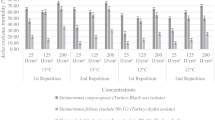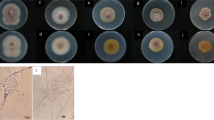Abstract
During a short survey of soil and mosquito breeding sites in Lucknow, India for potential mycopathogen from a period of August–October 1996, 11 species of fungi in 5 genera were isolated using live mosquito larvae as host. Aspergillus flavus , A. fumigatus and Fusarium semitectum were the most frequently isolated species. Other fungi recorded were A. niger , A. ochraceus , A. terreus , A. versicolor , Geotrichum candidum , Penicillium verrucosum , Paecilomyces sp. and Fusarium sp. (Liseola/Elegans complex). Insect cell walls are known to contain chitin, so fungal isolates were tested for their chitinase activity on semi synthetic medium containing colloidal chitin. High chitinolytic activities were observed with A. flavus and A. ochraceus. Chitinase producers can be considered as potential pathogens. However, the higher incidence of F. semitectum could not be explained by inability to utilize chitin.
Similar content being viewed by others
References
Russell RC, Panter C, Whelan PI. Laboratory studies on the pathogenicity of the mosquito fungus Culicinomyces to various species in their natural waters. Gen Appl Ent 1983; 15: 53‐63.
Jaronski ST, Axtell RC. Simplified production system for the fungus. Lagenidium giganteum for operational mosquito control. Mosq News 1984; 44(3): 377‐381.
Castillo JM, Roberts DW. Fungal pathogens, except Coelomomyces, of culicidae (mosquitoes) Bull WHO (1980) 58 (suppl) 69‐82.
Ferron P. Biological control of insect pests by entomogenus fungi. Ann Rev Entomol 1978; 23: 409‐442.
Badran RAM, Aly MZY. Studies on the mycotic inhabitants of Culex pipiens collected from fresh water ponds in Egypt. Mycopathologia 1995; 132: 105‐110.
Raper KB, Fennell DI. The genus Aspergillus. Baltimore: The Williams and Wilkins Company, 1965; 1‐686.
Raper KB, Thom C, Fennell D. A manual of the penicillia. Baltimore: TheWilliams and Wilkins Company, 1949; 1‐875.
Barnett HL. Illustrated genera of imperfect fungi: Burgess Publishing Company, 1965; 1‐225.
Shimahara K, Takiguchi Y. Preparation of crustacean chitin. Methods Enzymol 1988; 161(B): 417.
Guthrie WD, Lillehoj EB, Barry D, McMilan WW, Kwolek WF, Franz AO, Catalano FA, Russel WA, Widstrom NW. Aflatoxin contamination of preharvest corn; Interaction of European corn borer larvae and Aspergillus flavus group isolates. J Economic Entomol 1982; 75: 265‐269.
Ismail MA, Abdel-Sater MA. Fungi associated with the Egyptian cotton leafworm Spodoptera littoralis Boisdoval, Mycopathologia 1993; 124: 79‐86.
Zoberi MH, Grace JK. Fungi associated with the subterranean termite Reticulitermes flavipes in Ontario. Mycologia 1990, 82: 289‐294.
Toscano N, Reeves EL. Effect of Aspergillus flavus mycotoxin on Culex mosquito larvae. J. Invertebr Pathol 1973, 22: 55‐59.
Gambino P, Thomas GM. Fungi associated with two Vespula (Hymenoptera: Vespidae) species in the eastern San Francisco Bay area. Pan-Pacific Entomologist 1988; 64: 107‐113.
Kalvish TK, Kukharchuk IP. Pathogenic mycoflora of blood sucking mosquitoes of western Siberia and the Far East. Med Parazit Balenzi 1974, 43: 57‐64.
Samson RA. Paecilomyces and some allied hyphomycetes. Stud Mycol 1974; 6: 1‐119.
Bridge PD, Abraham YJ, Cornish MC, Prior C, Moore D. The chemotaxonomy of Beauveria bassiana (Deuteromycotina: Hyphomycetes) isolates from the coffee berry borer Hypothenemus hampei (Coleoptera: Scolytidae). Mycopathologia, 1990; 111: 85‐90.
Gupta SC, Leathers TD, El-Sayed GN, Ignoffo CM. Production of degradative enzymes by Metarrhizium anisopliae during growth on defined media and insect cuticle. Exper Mycol 1991; 15: 310‐315.
Nuero OM. Production of chitinase by Fusarium species. Current Microbiol 1995; 30: 287‐289.
Gupta S, Krasnoff SB, Underwood NL, Renmick JAA, Roberts DW. Isolation of beauvericin as an insect toxin from Fusarium semitectum and Fusarium moniliformae var. subglutinans. Mycopathologia 1991; 115: 185‐189.
Hamill RL, Higgens CE, Boaz HE, Gorman M. The structure of beauvericin, a new depsipeptide antibiotic toxic to Artemia salina. Tetrahedron Lett 1969: 49: 4255‐4258.
McLean M. The phytotoxicity of Fusarium metabolites: An update since 1989. Mycopathologia 1996; 133: 163‐179.
Rights and permissions
About this article
Cite this article
Sur, B. Survey of termite-inhabited soil and mosquito breeding sites in Lucknow, India for potential mycopathogens of Anopheles stephensi. Mycopathologia 144, 77–80 (1998). https://doi.org/10.1023/A:1007072806204
Issue Date:
DOI: https://doi.org/10.1023/A:1007072806204




